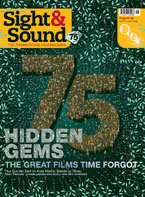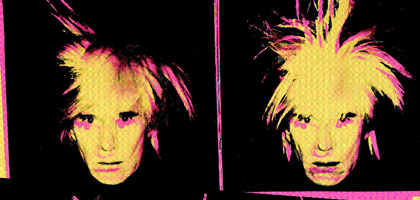
Roll Forever

Why has Andy Warhol's influence persisted when so many artists of his generation are being forgotten? Who better to consider that question than Gus Van Sant, the most Warhol-like film-maker around? Interview by Amy Taubin
Amy Taubin: It's very hard to pin down the relationship between your work and Andy Warhol's. Have you seen many of his films?
Gus Van Sant: I've never even seen The Chelsea Girls, but I have seen some of the Screen Tests because they're in a lot of museums now. I once saw an original of a Screen Test - not a print or a video - and it was amazing. He shot Plus-X reversal, which is the same filmstock I used on my 1985 film Mala Noche. It's really contrasty and rich, especially if it's underexposed.
The first Warhol film I saw was Trash. It was playing at the Guild Theater in Portland - this would have been around 1970. There was this guy outside waiting to go in - 30-ish, ex-junkie, gay - and he was checking us out. He said: "You come to these films a lot?" And we were going, "No, no, we don't." It was like something in a Warhol movie. If the film itself had an influence on me, it was probably because it showed you something you didn't see in other movies. Even in the 1950s, when he was drawing, Warhol showed you stuff you weren't supposed to draw: Cocteau-like penis drawings, pictures of sailors. I guess Kenneth Anger was the pinnacle of underground film at that time, and he had similar imagery.
When I started to try to make films, though, the scripts I wrote were John Cheever-esque stories about the place I came from - upper middle class, golf, country clubs. That's what fascinated me, but I never got to make any of them. Alice in Hollywood was my first film, and it was a reaction to living in Hollywood. It didn't do so well because it was a comedy and it wasn't very funny. So Mala Noche was like a regrouping and starting again. The setting and subject matter are something that might be in a Warhol movie but the technique was coming from Schlesinger or Bertolucci or Carol Reed. Midnight Cowboy, Last Tango in Paris and The Third Man were the three films I'd watch over and over again while I was constructing the story.
I always thought Pasolini…
It was like Pasolini by default - because it was gay and a street story and used non-professional actors. But for me then, Pasolini was too rough, not exact enough. And now I try to do that kind of stuff - it's like working backwards.
Why do you think there's such an interest in Warhol now?
It's kind of crazy, when other artists from that time are falling off. No one wants to know about William Burroughs any more, but with Warhol there's even more interest than when he was alive. I think it's his ability to make work that relates to today. His visual art seems like a 'souped up' version of appropriation, and appropriation influences so much in contemporary art. It was in the air back then: there were other people like Lichtenstein doing comic strips, but they were doing cleaner versions. And then he moved on - and it was a big jump, when you think about it - to Campbell soup labels. From what I've read, it's not just that his Mom gave him Campbell soup but she would make things out of the cans - cut them into flowers - so in creating the soup-can pieces he was getting closer to his own life, closer to himself.
That's different from most of the films, where he didn't use people he was close to.
It's so odd when you see an artist who has been struggling suddenly become the artist of the moment. In Warhol's case it was the curator Henry Geldzahler acquiring his work for the Metropolitan Museum. Once these big museums and galleries have your work then there are a thousand others throughout the world that need your work and have the money to pay for it. You can't even keep up with the demand, so a lot of artists create environments where they can pump out a lot of work because there's a market for it. I'm assuming that wasn't where Warhol's silk screening technique came from, but it came in handy. It's what financed his film-making: the films wouldn't exist unless he was selling art at a good rate. And because he has the money coming in from the art, he doesn't have to worry if the films make money, so it freed him from any responsibility towards viewership.
I always thought the film-making and the assembly-line product - he himself put in eight-hour days on the Factory assembly line - were a way to have people around and yet to be so busy he didn't have to deal with them directly.
Our costumer on Finding Forrester went to the Carnegie Institute at the same time as Warhol. We were begging her for information. She said, "I don't know. He was a weenie. We didn't talk to him." Perhaps there was a relationship between having an entourage around him all the time and his origins as the weenie in the class.
One of the comparisons you could make between Warhol and me is that we had a similar manner. I never really met him, but some of his close friends call us alter egos. I think it's the way we hold ourselves and experience life - we're both timid and adventurous at the same time. Lance Loud said Andy always looked as if he'd been left in the lurch, and when I'm in a club that's how
I look, even when I don't feel that way.
So certain similarities in the art come from that. One of my old boyfriends used to point out that everyone's personality becomes their style, and when you're in your 40s you begin to play with that. Like shyness becomes your style - it's your method of operation. So I don't think the similarities you see in the work are direct - like the influence specifically of his films on mine - but it's more that we had certain psychological similarities and they come out in the work as similarities in style. In my recent films I've been letting the camera roll forever, like he did in My Hustler. When I saw it originally I just thought it was a cheap way to make a movie, but later it felt good to do it: to shoot and not cut away, to keep watching.
I read the subtext of your new film 'Paranoid Park' as a gay initiation: the nice suburban kid is attracted to these skaters from the other side of the tracks who have a touch of criminality. And the relationship between sex and criminality is something you find throughout Warhol.
You're always taking your life experiences and rolling them into one piece of work. And as you continue making art, you become more refined in the way you do it. Usually my appreciation of an artist is when they are in their own work but you feel all the influences at the same time.
Didn't you once write a script about Warhol?
Right after Drugstore Cowboy in 1989 Universal asked Paul Bartel and me to write a script about him. We visited the Factory and met his business manager and executor Fred Hughes, who was in his office in his wheelchair. The only painting on the wall was a Warhol Electric Chair. Fred wanted to know why on earth we were going to make a film about 'him' because 'he' was the least interesting person on the planet. We handed in the script to Universal, and they said, 'No thanks'.
